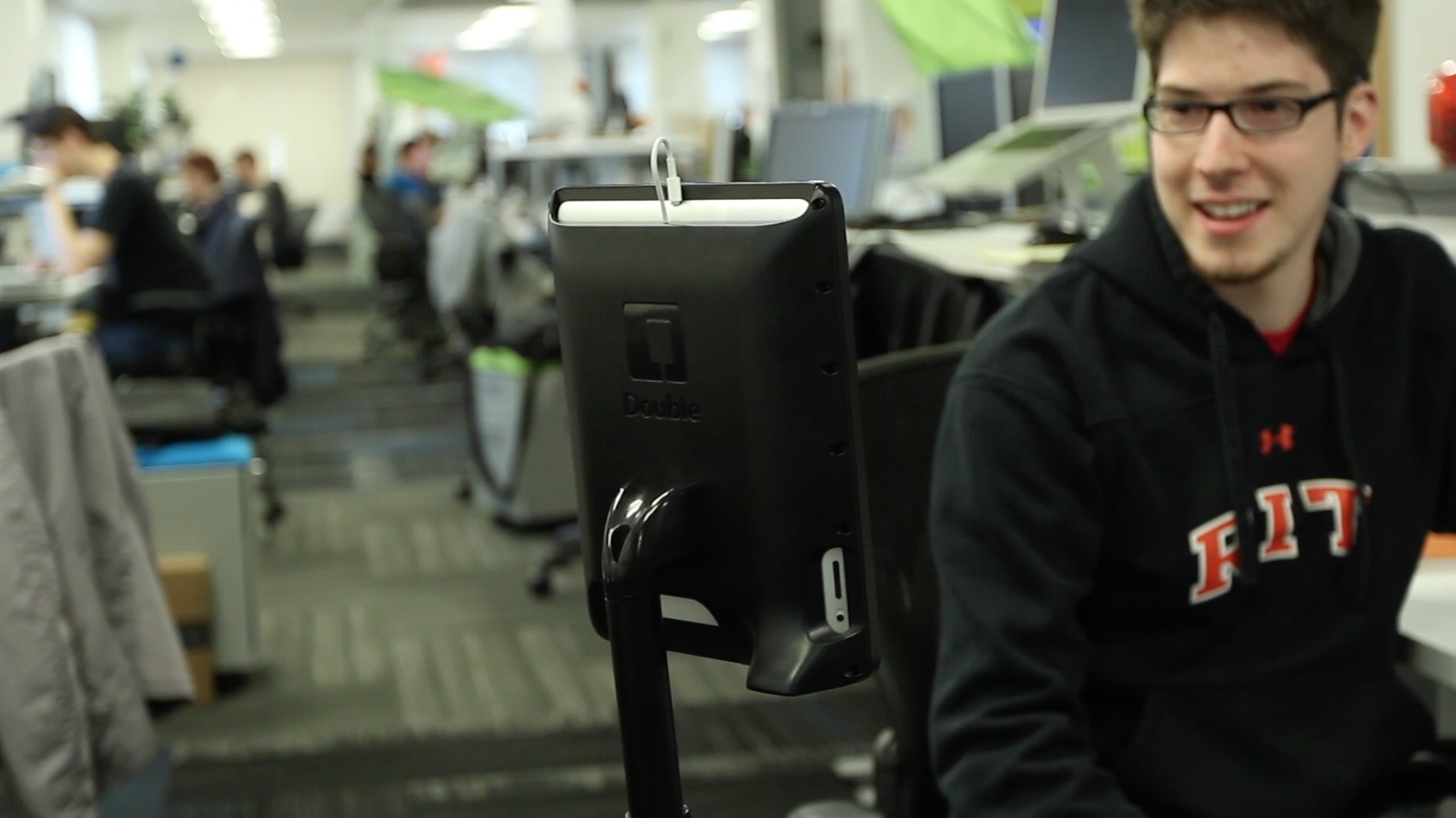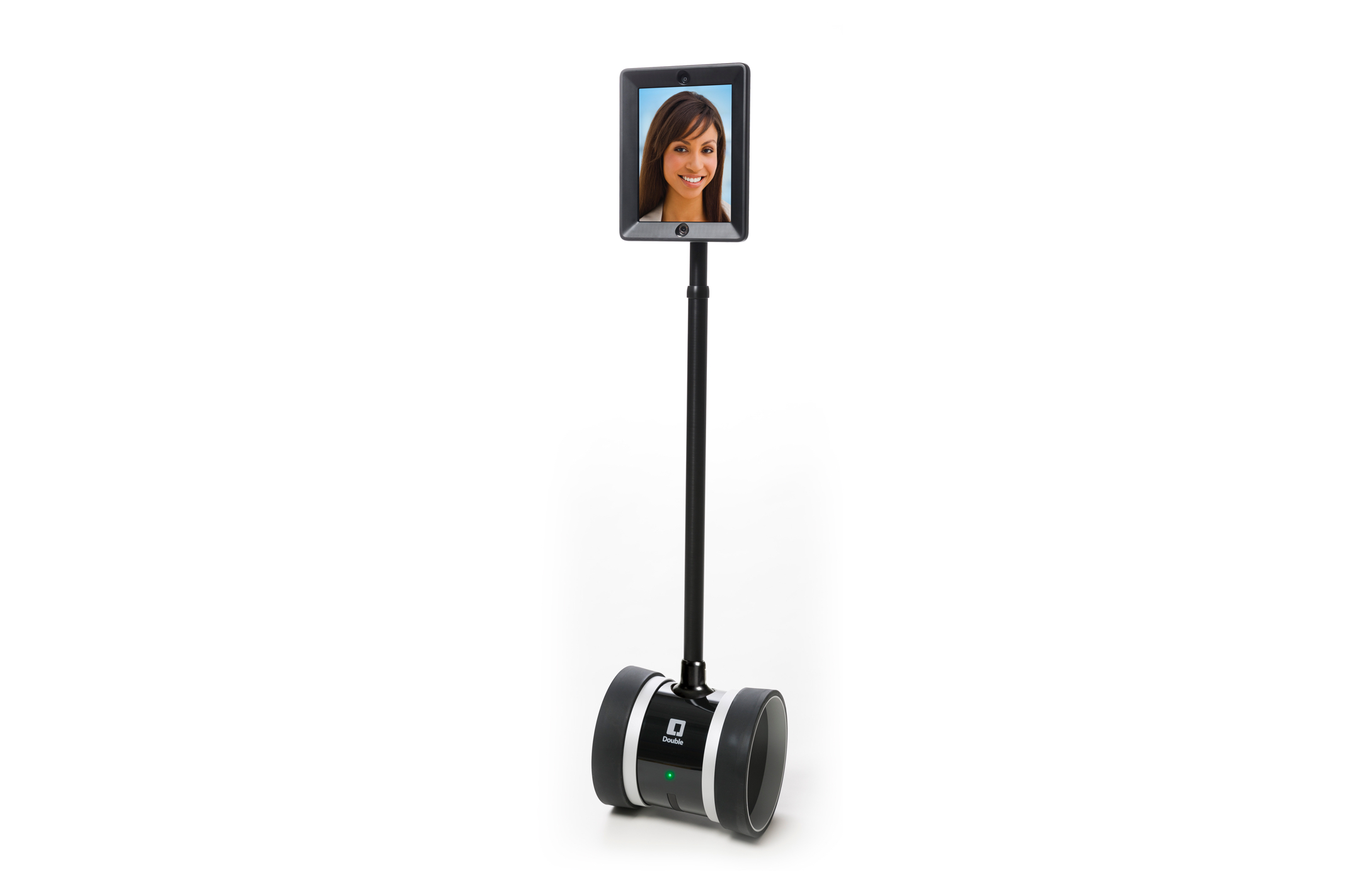Taking a Telepresence Robot for a Spin
4:43 minutes

What’s the polite way to say “I can’t make it to your party, but my robot can”?
It’s not a question many advice columnists have considered, but it may soon be time for a definitive how-to. Most telepresence robots are currently marketed for use in offices, schools, hospitals and other places with smooth terrain and reliable Internet. But as Evan Ackerman recently found out, telepresence robots are quickly becoming capable of “standing in” for us in even more everyday environments — like a family trip to the zoo.
Ackerman, a Maryland-based contributing editor for IEEE Spectrum, sent a telepresence robot in his stead on a family outing to the Portland Zoo. From his home on the East Coast, Ackerman joined the group in Oregon using Double Robotics’ Double 2 telepresence robot — essentially a long-stemmed iPad case on wheels.
“You can log into this iPad from any computer with internet, anywhere in the world, and you’ve got full control over the robot,” Ackerman says. “You get a video feed of everything the robot sees, while your face takes up the whole screen of the iPad on top, so that people can see you and talk to you at the same time.”
To be clear, the Double 2 is not designed for off-road use on hot, ice cream-covered pavement — it’s one of the models marketed toward schools and offices — but Ackerman says it performed admirably at the zoo.
“It’s designed to be used where you have really good Wi-Fi,” Ackerman adds. But at the zoo, he skirted technical requirements by using an iPad with an LTE cellular connection.
“I wandered around with it and saw the elephants and talked to people, and it really worked pretty well. It wasn’t perfect all the time, but it was definitely usable, which is better than I was expecting,” Ackerman says.

And as with any flashy technology used in public, the robot drew gawkers.
“The most fun was just wandering around and having people who had never seen a robot like this interact with me,” Ackerman says. “I was talking to people in Oregon just like I was there, and I was explaining it as, ‘Look, I’m just sitting at home about 3,000 miles away from you, but I’m here to see the elephants, too.’”
Ackerman’s brother in Portland accompanied the robot, in part to make sure that Ackerman, navigating from Maryland, didn’t run into anyone. Despite the guidance, Ackerman says there were moments when the “out-of-body” experience proved unnerving.
“When my brother wasn’t right there minding me, I had this sense of ‘OK, there’s this robot that’s thousands of miles away from me. And it’s my body — kind of,” Ackerman says. “But at the same time, someone could just pick it up and run off with it, and I wouldn’t be able to do anything. It’s a little bit weird.”
In the entire experiment, the robot’s network connectivity was the major drawback. But Ackerman thinks that with improvements to our network infrastructure — increased bandwidth, for instance — telepresence robots like Double 2 could reinvent armchair travel.
“I’m really excited for the future of telepresence,” Ackerman says. “Once we get this wireless infrastructure, you’ll be able to take robots like these anywhere. And I’m imagining that at some point, there’ll be places where you can rent them. So you could decide ‘Hey, I want to wander around Singapore today,’ and you just get off the couch, get on the computer and log in, and suddenly you’re in a robot. You can go explore Singapore and it’s way easier than flying. And I’m not saying it’s as good as being there, but you can do it from home and it’s cheap. So why not?”
Evan Ackerman is a contributing editor at IEEE Spectrum based in Bethesda, Maryland.
IRA FLATOW: And now it’s time to play Good Thing, Bad Thing, because every story has a flip side. You know how it is these days when you really need to be in two places at once, or you need to sit and wait for something to happen in place a, while you’d really like to be in place b. Well, why not send your telepresence robot? Your what?
Well, here to explain it is IEEE Spectrum’s Evan Ackerman, who tried it out. But he didn’t just send his robot to the 3:00 PM staff meeting. He sent it to the zoo to hang out with family members. And he joins us to talk about the good and bad of letting a telepresence robot do the walking. Welcome back to the program.
EVAN ACKERMAN: Hey, Ira. Great to talk to you again.
IRA FLATOW: Tell us what a telepresence robot is for people who don’t have one.
EVAN ACKERMAN: So this telepresence robot is called Double. It’s basically some wheels with a pole sticking up out of it. And on top of that pole is a case with an iPad in it. And you can log into this iPad from any computer with internet anywhere in the world, and you’ve got full control over the robot. And you get a video feed of everything the robot sees, while your face takes up the whole screen of the iPad on top, so that people can see you and talk to you at the same time.
IRA FLATOW: Hm. So let’s be clear about this. When they gave you this robot, this trip to the zoo is not what the robot was designed for, right?
EVAN ACKERMAN: Not at all. This is an indoor robot. It’s designed to be used where you have a really good WiFi. The company makes it specifically for places like offices and schools. And it works great in places like that. But if you have an iPad with this LTE cellular connection, it can technically work just about anywhere. So we wanted to try it out and see how well it does outside.
IRA FLATOW: So let’s talk about then what’s the good news about this– the good thing.
EVAN ACKERMAN: The good news is that it works outside. I took it to the zoo in Oregon. And I wandered around with it and saw the elephants and talked to people. And it really worked pretty well. It wasn’t perfect all the time, but it was definitely usable, which was a lot better than I was expecting.
IRA FLATOW: So what kinds of things did you do at the zoo with it?
EVAN ACKERMAN: The most fun was just wandering around and having people who had never seen a robot like this interact with me. Like, I was at home in Maryland and my family’s out in Oregon, so I was talking to people in Oregon just like I was there. And I was explaining to them, look, I’m just sitting at home about 3,000 miles away from you, but I’m here to see the elephants too.
IRA FLATOW: And did people come to accept that it was you and on the screen there?
EVAN ACKERMAN: It was funny, because a lot of people– I had my brother with me just to make sure that I didn’t actually run into anyone. And a lot of people just kind of talked to him, because they didn’t realize that I was on the other end of this thing. But once they did and once kind of they got over that initial novelty, it was just like having a conversation like I was right there.
IRA FLATOW: Did you come to think of the robot as physically being you? Did you sort of meld with the robot?
EVAN ACKERMAN: I did a little bit, you know. And it’s slightly unnerving at times, because when my brother wasn’t right there minding me, I kind of had this sense of, OK, there’s this robot that’s thousands of miles away from me. And it’s my body kind of, but at the same time someone could just pick it up and run off with it. I wouldn’t be able to do anything, so it’s a little bit weird.
IRA FLATOW: You could scream, I guess, help.
EVAN ACKERMAN: That’s about it though. Yeah.
IRA FLATOW: So what’s the bad thing here?
EVAN ACKERMAN: Oh. The bad thing is that it doesn’t really work as well as maybe it should. And that’s not the fault of the robot. It’s because we don’t have the kind of wireless infrastructure yet. When 5G shows up and we have a lot more bandwidth, this is going to work great. But at the moment, it can be a little bit trying sometimes when your signal drops out and you kind of realize there’s this robot that’s off doing something. And I don’t know what it’s doing, but it’s doing something.
IRA FLATOW: Yeah. I hate it when that happens. So what do you think the future of these robots is?
EVAN ACKERMAN: I’m really excited for the future of telepresence. Once we get this wireless infrastructure, you’ll be able to take robots like these anywhere. And I’m imagining that at some point there will be places where you can rent them. So you could just decide like, hey, I want to wander around Singapore today. And you just get off the couch, get on the computer, and log in. And suddenly you’re in a robot and you can go explore Singapore. And it’s way easier than flying. And I’m not saying it’s as good as being there, but you can do it from home. And it’s cheap. So why not?
IRA FLATOW: I’m going to give it a shot. Thank you for taking time to be with us today.
EVAN ACKERMAN: Oh, no problem. Thanks, Ira.
IRA FLATOW: Good luck with your own robot. Evan Ackerman, the contributing editor of the IEEE Spectrum.
Copyright © 2016 Science Friday Initiative. All rights reserved. Science Friday transcripts are produced on a tight deadline by 3Play Media. Fidelity to the original aired/published audio or video file might vary, and text might be updated or amended in the future. For the authoritative record of ScienceFriday’s programming, please visit the original aired/published recording. For terms of use and more information, visit our policies pages at http://www.sciencefriday.com/about/policies/
As Science Friday’s director and senior producer, Charles Bergquist channels the chaos of a live production studio into something sounding like a radio program. Favorite topics include planetary sciences, chemistry, materials, and shiny things with blinking lights.